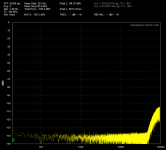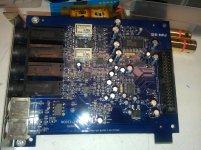Comparing THD --
Here is some more info regarding measurement accuracy -->
I ran two notch depths (-40 and -60db notch depth) and read the 2H, 3H 4H and 5Harmonic levels from the QA400.
I also compared the results against the ShibaSoku AD725D, Audio-Precision 2722 and Panasonic 7722A. The signal source was from the Panasonic 7722A.
With 60dB notch on the QA400, I got:
-120dB re 1v/1KHz for 2H
-122dB for 3H
-133dB for 4H
-140dB for 5H
With 40dB notch on QA400 input I got:
-120dB for 2H
-127dB for 3H
-133dB for 4H
-135dB for 5H
The largest affect from notch depth is on the odd harmonics. Notch is from an 'active' B&K 1607 variable notch filter. With my filter Q/phase etc., the 40dB depth seems to be a little more accurate.
The Harmonic values from the AP 2722 analyzer are:
-120dB for 2H
-131dB for 3H
-136dB for 4H
-138dB for 5H
The Harmonic values measured with the ShibaSoku AD725D are:
-119dB for 2H
-125dB for 3H
-135dB for 4H
-136dB for 5H
The Harmonic values from Panasonic 7722A are:
-125dB for 2H
-126dB for 3H
-136dB for 4H
-137dB for 5H
Thx-RNMarsh
Here is some more info regarding measurement accuracy -->
I ran two notch depths (-40 and -60db notch depth) and read the 2H, 3H 4H and 5Harmonic levels from the QA400.
I also compared the results against the ShibaSoku AD725D, Audio-Precision 2722 and Panasonic 7722A. The signal source was from the Panasonic 7722A.
With 60dB notch on the QA400, I got:
-120dB re 1v/1KHz for 2H
-122dB for 3H
-133dB for 4H
-140dB for 5H
With 40dB notch on QA400 input I got:
-120dB for 2H
-127dB for 3H
-133dB for 4H
-135dB for 5H
The largest affect from notch depth is on the odd harmonics. Notch is from an 'active' B&K 1607 variable notch filter. With my filter Q/phase etc., the 40dB depth seems to be a little more accurate.
The Harmonic values from the AP 2722 analyzer are:
-120dB for 2H
-131dB for 3H
-136dB for 4H
-138dB for 5H
The Harmonic values measured with the ShibaSoku AD725D are:
-119dB for 2H
-125dB for 3H
-135dB for 4H
-136dB for 5H
The Harmonic values from Panasonic 7722A are:
-125dB for 2H
-126dB for 3H
-136dB for 4H
-137dB for 5H
Thx-RNMarsh
Last edited:
That's really good consistency I think.
How did you adjust the notch depth? Which opamp is in the tweaked B&K? (I need to do that to mine.)
If possible try it again at 3V. At 1V most of these boxes are running into internal noise limits. Also the 2nd Harmonic seems higher than I would have expected. Is the Shibasoku AG16 generator similar? I remember something like -130 for all the harmonics.
How did you adjust the notch depth? Which opamp is in the tweaked B&K? (I need to do that to mine.)
If possible try it again at 3V. At 1V most of these boxes are running into internal noise limits. Also the 2nd Harmonic seems higher than I would have expected. Is the Shibasoku AG16 generator similar? I remember something like -130 for all the harmonics.
Affect of null depth on THD measurement
I didn't want to use the -130dB machine... I wanted some distortion to measure 🙂
I adjusted the notch depth by tuning to a slightly different frequency. Well, it seems to work OK.
I don't recall the opamp I used... its in the forum somewhere... would have to open it up to find out. But probably my favorite LT1468 ... the opa134 was recommended, however.
The 2H has always been a problem with the QA400. Might be opamps used or coupling caps??
Variance is greater than the +/- 1dB spec for harmonic accuracy from some of the high priced models..... But, for the quick and easy way of doing things, the results prove to be 'good enough' for government work.
😎🙂
-RM
I didn't want to use the -130dB machine... I wanted some distortion to measure 🙂
I adjusted the notch depth by tuning to a slightly different frequency. Well, it seems to work OK.
I don't recall the opamp I used... its in the forum somewhere... would have to open it up to find out. But probably my favorite LT1468 ... the opa134 was recommended, however.
The 2H has always been a problem with the QA400. Might be opamps used or coupling caps??
Variance is greater than the +/- 1dB spec for harmonic accuracy from some of the high priced models..... But, for the quick and easy way of doing things, the results prove to be 'good enough' for government work.
😎🙂
-RM
Last edited:
Richard you have me stumped. How did you get that notch on the (input?) to the QA? Did you use one of your other analyzers slightly offset?
Jan
Jan
Richard you have me stumped. How did you get that notch on the (input?) to the QA? Did you use one of your other analyzers slightly offset?
Jan
^ see #661, above. Middle of page.
-RM
No I mean the method you used to get that particular notch into the QA, the test setup. Or am I missing the obvious?
Jan
Jan
That's really good consistency I think.
Which opamp is in the tweaked B&K? (I need to do that to mine.)
.
DM -
I just checked the B&K 1607 topic (on page 4 of this forum) and saw in a photo that I used the recommended B-B OPA134.
-RM
Last edited:
No I mean the method you used to get that particular notch into the QA, the test setup. Or am I missing the obvious?
Jan
You just need a variable frequency notch filter. Or, a fixed notch freq and a variable freq generator/source. When the two are not at the same freq, the atten of the notch is reduced. Just adjust notch frequency slightly off the generator freq while monitoring the gen freq atten until it is -40dB or what ever you want.
.... best to have notch freq slightly below the gen freq.
If I had available a fix notch filter tuned to max atten at 1KHz, then I would have used it.... instead I had a variable notch freq filter available.
Thx-RM
Last edited:
Nice feedback from QA. Notice their caution about noise.
" Note the QA400 has a noise bump that starts just below 50K (attached picture shows no-input ADC noise floor). This is characteristic of most all sigma-delta ADCs. This may or may not interfere with your desired IM measurements. "
I want one, no question. I just need to find an excuse to get one. They do caution they use unique IO and data formats so they are not suitable for use on other software. That is part of why they can get the performance they show.
" Note the QA400 has a noise bump that starts just below 50K (attached picture shows no-input ADC noise floor). This is characteristic of most all sigma-delta ADCs. This may or may not interfere with your desired IM measurements. "
I want one, no question. I just need to find an excuse to get one. They do caution they use unique IO and data formats so they are not suitable for use on other software. That is part of why they can get the performance they show.
Attachments
I see that same rise in noise floor around 50kHz with my M-Audio 24192 and Pete Milletts sound card interface. I paid a good deal more for the combination so the QA400 strikes me as a pretty good deal for the performance offered.
The rise in noise is from the noise shaping. They push the in band noise out to a higher frequency. But apparently not far enough.
There are very few ADC's that do not have this issue. The only current one I know of is the AK5394A. On that device they moved the noise shaping to above 100 KHz.
Are there any sound cards that employ the AK5384a?
Lynx Two, L22.. but it would be a better choice to start a DIY project 😀 and feed the ADC/DAC with SPDIF digital I/O from the sound card.
Hp
The EMU 1212M and the EMU 1616M both use the AK5394A. They are essentially discontinued. It seems the market for internal sound cards has been replaced with external and mixed solutions (similar to the 1616M). However you may be able to find one like I did for a fair price. The drivers are known to be buggy/unstable.
I would like an external solution, preferably not USB because of all the hassles getting USB working right and getting isolation. I'm building a box with two AKM demo boards but that would be nonsense if they were not here already.
Even a DIY project would probably cost more than $200 in parts.
Closeup of EMU 1212M below, before I start modding it.
I would like an external solution, preferably not USB because of all the hassles getting USB working right and getting isolation. I'm building a box with two AKM demo boards but that would be nonsense if they were not here already.
Even a DIY project would probably cost more than $200 in parts.
Closeup of EMU 1212M below, before I start modding it.
Attachments
We haven't explored TCPIP as a means for getting the data transferred. Much faster than USB, galvanically isolated and Microsoft can't mess with it.
Unfortunately Ethernet would require almost a junior computer to run the device. There are several standards for audio over ethernet, they either are more like a streaming protocol for internet music or are almost completely incompatible with a normal network. And then getting the software to talk to the audio device appearing in a strange place. Not impossible but a lot more software to deal with. SPDIF really does work and really doesn't have jitter problems when implemented correctly.
A Juli card as an interface into a PC is the simplest and cheapest way to get a stable connection for SPDIF I have found. Making a replacement for the existing analog card could be a good option, not easy but probably easier than the other options here. I would support such an effort.
A Juli card as an interface into a PC is the simplest and cheapest way to get a stable connection for SPDIF I have found. Making a replacement for the existing analog card could be a good option, not easy but probably easier than the other options here. I would support such an effort.
I just started a thread on the EMU 1212M here: http://www.diyaudio.com/forums/equipment-tools/248720-emu-1212m-measurements.html#post3766044 I'll have more to add in about 12 days (after CES).
- Home
- Design & Build
- Equipment & Tools
- QuantAsylum QA400 and QA401

